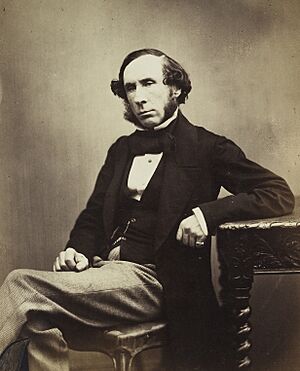George Owen Rees facts for kids
George Owen Rees (born November 1813 – died 27 May 1889) was an important Welsh-Italian doctor. He made many discoveries about blood and urine. He also helped improve how doctors understood and treated kidney diseases.
Life
Early Life and Education
George Owen Rees was born in November 1813 in Smyrna (now Izmir, Turkey). His father, Josiah Rees, was a merchant and a British consul there. His mother was from Newfoundland, Canada. George went to a private school in Clapham, England. He learned French, German, and Italian.
In 1829, George began studying medicine at Guy's Hospital in London. He also studied in Paris in 1836. Later, he went to Glasgow University to study botany and surgery. He earned his medical degree (M.D.) in 1836. After that, he started working as a doctor in London.
Medical Career
Thanks to Sir Benjamin Brodie, George Rees became the first doctor at Pentonville prison. In 1843, he became an assistant doctor at Guy's Hospital. He became a full doctor there in 1856. He worked at Guy's Hospital for 30 years before retiring in 1873.
Rees was elected a Fellow of the Royal Society in 1843. This is a very high honor for scientists. He also held important positions at the Royal College of Physicians. He gave many lectures there about medicine. For example, he lectured about blood and kidney diseases.
Later in his life, Rees became a consulting doctor for the Queen Charlotte Lying-in Hospital. He was also a special doctor to Queen Victoria. He often worked with Alfred Swaine Taylor, a forensic expert, on legal cases. His patients often had kidney disease or gout. He believed that lemon juice could help treat severe rheumatism.
In 1886, George Rees had a stroke that made him unable to work. He passed away on 27 May 1889, at Mayfield, Watford. He was buried in Abney Park cemetery.
Discoveries and Writings
Early in his career, George Rees worked with Richard Bright. Bright was a famous doctor who studied kidney diseases. Rees helped him analyze kidney stones and other body fluids. He found out how much protein and urea were in urine. He also proved that urea was present in the blood.
In 1838, Rees showed how sugar could be found in the blood of people with diabetes. Before this, doctors were not sure it was there. He also studied a milky fluid from a patient's abdomen. He found it was chyle, a fluid from the digestive system. He also analyzed bones in a disease called mollities ossium.
In 1841, Rees studied blood cells with Samuel Lane. They described how blood cells looked like flat capsules with colored fluid. They also showed how these cells changed when different liquids were added. He later studied the center of blood cells in different animals. He also showed that white corpuscles were similar to cells found in lymph and pus.
Rees wrote several important papers for the Royal Society. These included papers on the chemical analysis of fluids in the human body. He also wrote about the job of red blood cells and how blood gets oxygen.
Rees also helped edit a large medical book by Jonathan Pereira. His own published works include:
- On the Analysis of the Blood and Urine in Health and Disease, first published in 1836.
- Observations on the Diagnosis of Bright's Disease (1845).
- On a Remarkable Case of Paraplegia (1845).
- Articles on "Lymph", "Chyle", and "Milk" in a medical encyclopedia.
See also
List of Welsh medical pioneers


